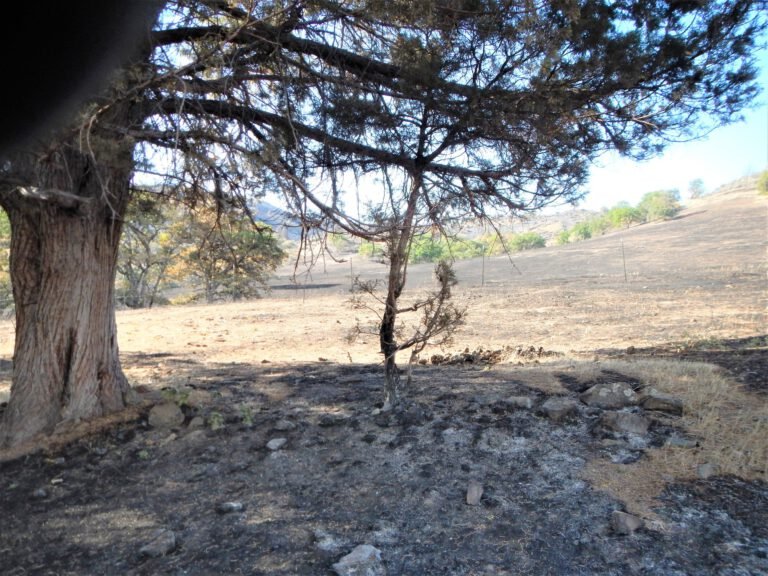Even with all the so-called costly taxpayer-funded wildfire fuels reduction programs using recommended burning, biomass processing, and so on, both the frequency and intensity of wildfires in California and elsewhere have increased!
Year over year, we are having more fires with greater intensity and damage, not less!
Obviously some lawmakers who cant let-go of their stopped working posits relating to the existing fuels reduction programs will simply say; We Need More Money” …
But more money and doubling down on whats plainly not working is simply insanity.
There are some individuals who will be made unpleasant by this post, since they like the existing paradigm of being spent for failure. And we can anticipate them to protect what has actually indeed stopped working.
We need a more comprehensive, efficient, and naturally sustainable wildfire fuels decrease paradigm …
And as it so happens, we have an effective unused tool sitting in the toolbox.
We require to review the existing, stopped working fuels decrease paradigm, which is costing taxpayers a lot in money, and via increasing losses from wildfire.
Some people are easily sidetracked and take their eye off the ball and striking-out, getting lost in all the rhetoric and misinformation, which in this case results in costly disaster.
And some individuals, consisting of some legislators/officials and reporters, who are poorly informed on all elements of wildfire (including the chemistry of combustion), puzzle others and the dispute by discussing sources of ignition or types of fuel (kinds of lawn or brush) or areas.
Catastrophic Wildfire Is A Fuels Problem At Its Core!
Leading published science reveals that as an outcome of the collapse of our native species herbivory (animals that take in yard and brush) across much of the western U.S. landscape, a boost in both the strength and frequency of wildfire is expected. [1] The KEY: No fuel = No fire, regardless of winds or ignition source.
The existing fuels reductions programs of bio-massing and recommended burns (and now, contaminating lands by putting chemical retardants on the landscape) are now empirically proven as problematic paradigms for the following factors when used to wilderness areas:
Costs are really high for the amount of fuel removed; and
Key one-hour-class wildfire fuels (yard and brush) are annually repeating; and,
Prescribed burns are costly, can develop into lethal wildfires, pasteurize/damage soils and soils biome, and likewise send out carbon compounds into the environment; and,
Recommended burns eliminate wildlife (further exacerbating the loss of herbivory) and leaves the landscape subject and barren to disastrous erosion, which harms fisheries; and,
Bio-mass processing is not practical on 10s of countless acres of remote designated wilderness that is at danger for wildfire, and where motorized lorries and equipment are prohibited.
The crucial elements to develop fire. Without fuel, there can not be fire! Wind = oxygen; heat = ignition; grass and brush = fuels.
No matter the kind of flashy hot-burning fuel at hand, or where it is situated, when it ends up being excessive and dry, its prime for catastrophic wildfire.
Three bottom lines:
We CAN NOT control sources of ignition, aka: Heat (downed power lines, arson, chains dragging on roads, cigarettes, camp fires, and so on).
We Can not manage the wind or the outdoors temperature.
We CAN control fuels naturally using a symbiotic native types (wild horses) herbivory.
An Important Part Of The Solution: Reestablishing The Native Species Herbivory!
The juniper tree in the picture above was used for shelter by wild horses (note horse droppings). Flames from the Klamathon wildfire burned right under this tree, yet it survived having been made fire-resilient by the combined symbiotic actions of wild horses, permitting this tree to endure where other close-by trees that were not utilized by wild horses became matchsticks!
Trees that were being used by wild horses as shelters had the fuels (turf and brush) under their canopies grazed-down so flame heights under trees were greatly lowered. And these large-bodied herbivores (wild horses) scratch themselves using the lower dead branches on these trees (aka: fire-ladders), breaking them off. The aggregate result of this symbiotic habits (tree provides shelter, horses supply fertilizer and fuels reduction making trees fire durable) saves trees, and demonstrates how wild horses are the protectors of forests and wildlife.
There is no doubt that the regional wild horses assisted to conserve the precious Soda Mountain Wilderness Area from the fatal Klamathon Fire of 2018.
Like some numerous other western state areas, Siskiyou County California experiences winds into the 60-70 mph variety several times a year, so its only a matter of time until we get what I am now going to call the Boulder Effect; high winds + abundant flashy fuels = catastrophic wildfire.
References:
Collapse of the worlds largest herbivores: “By altering the quantity and circulation of fuel products, large herbivores can form the frequency, intensity, and spatial distribution of fires throughout a landscape”. William J. Ripple1, Thomas M. Newsome1,2, Christopher Wolf1, Rodolfo Dirzo3, Kristoffer T. Everatt4, Mauro Galetti5, Matt W. Hayward4,6, Graham I. H. Kerley4, Taal Levi7, Peter A. Lindsey8,9, David W. Macdonald10, Yadvinder Malhi11, Luke E. Painter7, Christopher J. Sandom10, John Terborgh12 and Blaire Van Valkenburgh13http:// advances.sciencemag.org/content/1/4/e1400103.full.
“The removal of large herbivores has unfavorable effects on landscape structure and ecosystem functioning. In wetter ecosystems, the loss of large herbivores is associated with an increased abundance of woody plants and the development of a closed-canopy greenery. In drier ecosystems, reductions of big grazers can lead to a high turf biomass, and therefore, to an increase in the frequency and intensity of wildfires.
Foods of wild horses, deer, and cattle in the Douglas Mountain location, Colorado.Hansen, R. M., Clark, R. C., & & Lawhorn, W. (1977 ). Journal of Range Management, 30( 2 ), 116-118. https://repository.arizona.edu/handle/10150/646893.
Influence of ruminant gastrointestinal procedures on germination of ingested seeds; https://ir.library.oregonstate.edu/concern/graduate_thesis_or_dissertations/v405sg230.
Ruminant Digestion: https://www.mun.ca/biology/scarr/Ruminant_Digestion.html.
https://www.researchgate.net/publication/318163234_Pleistocene_megafaunal_extinctions_and_the_f unctional_loss_of_long-distance_seed-dispeersal_services.
https://www.thesprucepets.com/horse-manure-facts-1887394.
About the Author.
William E. Simpson II is an ethologist living amongst and studying free-roaming native species American wild horses. William is the acclaimed producer of the micro-documentary movie Wild Horses. He is the author of a brand-new Study about the behavioral ecology of wild horses, two published books and more than 150 released posts on subjects related to wild horses, wildlife, wildfire, and public land (forest) management. He has actually appeared on NBC NEWS, ABC NEWS, theDoveTV and has actually been a guest on numerous talk radio shows consisting of the Lars Larson Show, the Bill Meyer Show, and on NPR Jefferson Public Radio.
Have a look at Williams Film Freeway account for movies, studies, TELEVISION & & radio interviews, and more HERE: https://filmfreeway.com/WilliamESimpsonII.
Updated on Jan 3, 2022, 12:46 pm.
The image (by William E. Simpson II) above programs native plants and yards springing-forth from wild horse droppings. The unique digestive system of wild horses permits the seeds they eat to pass undamaged and able to sprout from the humus and micro-biome likewise contained in horse droppings. Ungulates (livestock– sheep) have complicated stomachs and chew a cud, and they digest virtually all of the seeds of the native plants and grasses they consume. As such, secured wilderness areas with unusual plants and reliant animals ought to never be grazed by cattle or sheep, which leads to the stripping-off of native flora.
* A native species American wild horse consumes about 5.5 lots of wildfire fuels (grass and brush) every year. And even as they graze, unlike ungulates (livestock & & sheep), wild horses unique digestive system pass the seeds of native plants they eat back out onto the landscape, which is the outcome of a co-evolved cooperative relationship in between the yards and plants and wild horses. The plants and yards supply nutrition to the horse, and the horse benefits these lawns and plants by distributing their seeds undamaged back onto the ground!
* An average deer consumes about 1.3-tons of wildfire fuels each year.
The Hunting Industry Needs To Pay Attention Here!
They are utilizing forage required by deer. Wild horses only have a 1% grazing overlap with deer!
We can, in an environmentally suitable and cost effective manner, control wildfire fuels utilizing large-bodied herbivores, specifically non-ungulates (horses) that reseed native plants.
3 Step Solution in Critical Priority
Rewilding native types American wild horses from taxpayer-funded ($ 100-M/year) off-range holding corrals and into chosen wilderness locations that are inadequate to prescribed fire and/or bio-mass processing; and,
Moving wild horses from areas where they are in conflict with animals production and other public lands uses (where such wild horses go through roundups and inappropriate chemical treatments) and putting them as family into remote designated wilderness areas; and,
Start a 5-year moratorium on all searching of cervids (deer and elk) in the western United States. This will help enable a come-back of native cervids that will assist with natural wildfire fuels reduction.
An Important, Yet Unused Tool
The strategy understood as: The Natural Wildfire Abatement and Forest Protection Plan (aka: Wild Horse Fire Brigade) offers an existing legal path to allow rewilding and relocation of wild horses (and burros) into designated wilderness areas that are both environmentally and economically proper. https://grazelife.com/blog/wild-horse-fire-brigade-lessons-in-rebalancing-north-american-ecosystems-by-rewilding-equids/
The Plan: This published article at the Sierra Nevada Ally highlights the problems around the currently flawed wild horse management, and importantly, includes a comprehensive summary of how an authentic sustainable solution for wildfires and wild horses can be carried out: https://www.sierranevadaally.org/2021/12/23/comsumerism-vs-wild-horses/
Its a fact that we have a collapsed native species herbivory in the western United States.
The leading science informs us that native herbivores are very effective in the seamless sustainable wildland fuels management of lawn and brush.
The Bureau of Land Management (BLM) under the Department of Interior is removing big native herbivores (wild horses) from lots of locations where their populations are indicated as exceptionally advantageous for wildfire protection and for conservation of forest communities, wildlife, fisheries and watersheds. We frantically require enhancement (more horses, not less) in some locations in order to have a better distribution of wildfire fuel reduction results in the designated wilderness locations surrounding our rural towns and cities that stand in the course of wildfires that are coming from such locations.
The BLM (and the USFS) is using a one-size fit all wild horse management paradigm, which is environmentally and financially flawed.
The entire BLM wild horse management paradigm is postulated upon clinically debunked misconceptions.
Contrary to the BLMs false proffering; all north American predators (bears, wolves, mountain lions and coyotes) are the co-evolved predators of wild horses; and, wild horses did not go extinct 12-14 thousand years back during the last Ice Age.
In reality, brand-new science proves that wild horses in North America lived after the Ice Age, just 5,000 years earlier!
And, as science programs, the existing wild horse management debacle leads to the boost of both the frequency and strength of wildfire.
As we have actually now seen (as I have actually written, time and time once again) in Boulder County Colorado, wildfires can take place anytime of the year when the yard and brush one-hour class fuels end up being excessive, which is a persistent circumstance in the western U.S. states offered the collapse of our native herbivory populations of cervids (deer, elk, etc).
If we concentrate on affordable Prevention via reestablishing our native herbivory, beginning with a widespread deployment of the offered wild horses into selected wilderness locations, sad tales like Boulder County Colorado can be decreased …
Boulder County Colorado Fire:
Plain Fact: Boulder County Colorado had too much flashy yard and brush fuels that were and all set for ANY source of ignition. The winds included plentiful oxygen (like the old-school bellows on a blacksmiths heater) so the Boulder County wildfire burned additional quick and hot … During the Klamathon Fire (2018) here in Siskiyou County California, we experienced a sample of what 30-40 miles per hour winds and plentiful lawn and brush fuels might do … and it was expensive!
We likewise saw first-hand how our local small herd of wild horses assisted CAL-FIRE to stop that wildfire from entering the uber-heavy fuels of the Cascade-Siskiyou National Monument and Soda Mountain Wilderness Area.
The distinct digestive system of wild horses enables the seeds they eat to pass able and intact to germinate from the humus and micro-biome also included in horse droppings. And even as they graze, unlike ungulates (cattle & & sheep), wild horses special gastrointestinal system pass the seeds of native plants they eat back out onto the landscape, which is the result of a co-evolved cooperative relationship in between the turfs and plants and wild horses. The grasses and plants provide nutrition to the horse, and the horse benefits these yards and plants by distributing their seeds undamaged back onto the ground!
The aggregate result of this cooperative habits (tree supplies shelter, horses supply fertilizer and fuels decrease making trees fire resilient) saves trees, and reveals how wild horses are the protectors of forests and wildlife.
He is the author of a new Study about the behavioral ecology of wild horses, 2 released books and more than 150 published articles on topics associated to wild horses, wildlife, wildfire, and public land (forest) management.
Its the New Year (2022 ), however Sadly, were starting the year with a horrific mid-winter incinerating wildfire in Boulder County Colorado and that unfolding disaster.
[soros] Q3 2021 hedge fund letters, conferences and moreHere Is Dan Loebs Second-Favorite Hedge Fund After Third PointMany popular hedge fund managers provide to charity, and some have even developed their own structures to distribute their millions of dollars. Dan Loeb of Third Point is one of those who have actually produced their own foundation, and we can find out which hedge funds he trusts by reviewing the current 990 declare his structure. Read MoreGiven this catastrophe and the suffering, is it reasonable to ask that you to take 10-minutes out of your day to understand whats occurred, and how you can help prevent future disasters like this?
I am not paid or inspired by money, I am inspired due to the fact that I personally know their discomfort having actually suffered the loss of a human life due to wildfire.
And unlike so lots of people in the dispute, I have studied the science of wildfire, and I have been on the fire-line in the front of the oncoming intense dragon; I have actually checked out its eyes and breathed its breath.
” Those who can not remember the past are condemned to repeat it.”– George Santayana
How rapidly have the wind-whipped incinerating wildfires in California over the previous 5-years slipped from memory?
The big concern is: Has anyone learned anything?




